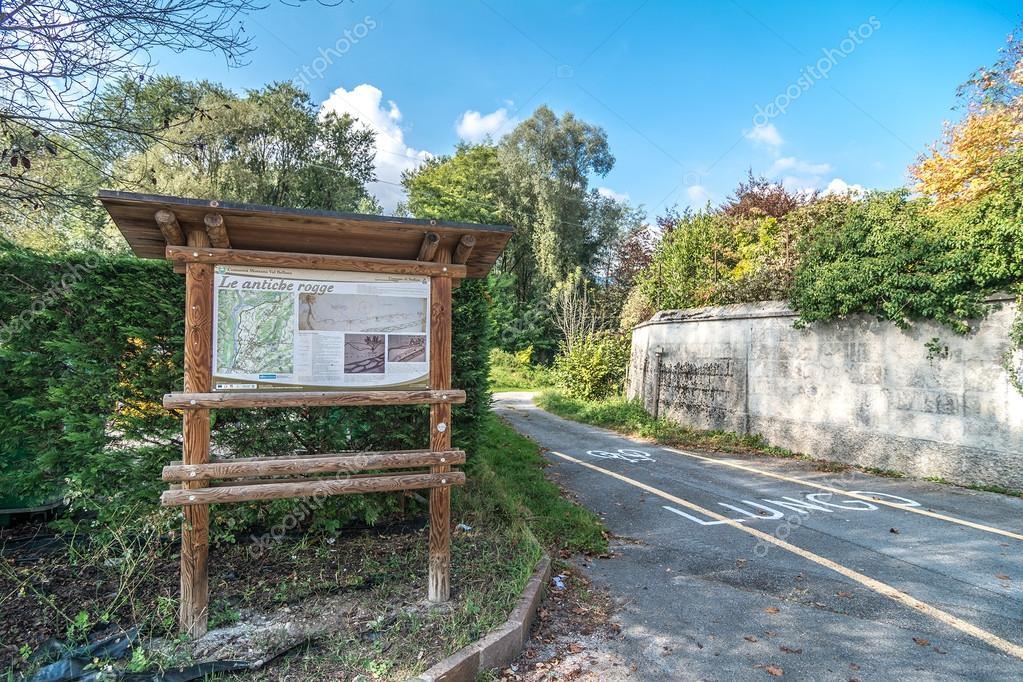Le Antiche Rogge: un poco di storia
 Fino alla prima metà del Novecento era segnato da un fitto reticolo di rogge (canali artificiali) che alimentavano le attività più disparate: Sedico era costellata di opifici, segherie, mulini, fucine, perfino una cartiera, da metà Ottocento.
Fino alla prima metà del Novecento era segnato da un fitto reticolo di rogge (canali artificiali) che alimentavano le attività più disparate: Sedico era costellata di opifici, segherie, mulini, fucine, perfino una cartiera, da metà Ottocento.
L’acqua e il legno erano il motore principale dell’economia lungo il Cordevole.
Il legname scendeva lungo il torrente dall’Agordino. Ciascun tronco era inciso con un segno che lo destinava a una delle tante segherie sorte nei secoli vicino al Cordevole.
Nei pressi della segheria i tronchi (o meglio, le taie) venivano deviati in un canale la cui acqua faceva confluire la materia prima nello stabilimento e forniva l’energia idraulica necessaria per il funzionamento delle seghe (le mèle).
Agli inizi del Novecento scendevano dall’Agordino diecimila taie all’anno.
Prima, anche fino a ventimila. I tronchi lavorati venivano poi rimessi in acqua in forma di zattere e portati fino a Venezia. Tuttora, non a caso molte aziende della zona sono legate alla lavorazione del legname.
Le lame per le mèle lavorate dai Buzzati, ricchi commercianti della zona, erano rinomate anche all’estero fin dal Cinquecento.
A Bribanét i Buzzati fecero costruire nel XVI secolo un piccolo oratorio: c’è ancora, naturalmente rimaneggiato.
Sull’architrave del portale d’ingresso spicca lo stemma di famiglia, una lama per sega.
L’oratorio è dedicato a san Nicolò, patrono di chi lavora o va per le acque: protettore di marinai, zattieri e menadàs (i menadàs si occupavano della fluitazione dei tronchi).
 L’itinerario si snoda lungo la riva sinistra del Cordevole da Bribano fino al Sasso di San Giorgio, con un prolungamento fino al nuovo ponte in località Tappole di fronte a Sass Muss.
L’itinerario si snoda lungo la riva sinistra del Cordevole da Bribano fino al Sasso di San Giorgio, con un prolungamento fino al nuovo ponte in località Tappole di fronte a Sass Muss.
Il percorso permette di conoscere una parte importante della storia industriale del nostro paese e di godere delle bellezze naturali connesse alla connotazione delle aree ripariali del Cordevole.
Il nascondiglio oltre ad essere raggiungibile in auto senza perdite di tempo, può essere raggiunto dal sentiero ciclabile delle Antiche Rogge con una passeggiata di 20' (10' in bici) partendo da Bribano ed arrivando all'uscita del sentiero nella zona di Sedico / Villa Pat.
Volendo poi è possibile anare alla ricerca di altre cache o proseguire per chilometri e chilometri in direzione Mas (Sass de Mus) su questo sentiero che è praticato sia a piedi sia in mountain bike.
La Cache
la cache si trova in una comoda posizione su strada asfaltata all'uscita della prima porzione di sentiero che parte da Bribano ed esce sotto Villa Pat.
Vista la presenza di alcune casi nei paraggi, è richiesta un minimo di furtività per evitare che qualche babbano si insospettisca e possa poi scovare il nascondiglio.
********************* ENGLISH ***********************
Le Antiche Rogge: a bit of history
Until the first half of the twentieth century it was marked by a dense network of irrigation ditches (artificial canals) that fed the most diverse activities: Sedico was dotted with factories, sawmills, mills, forges, even a paper mill, from the mid-nineteenth century.
Water and wood were the main engine of the economy along the Cordevole.
The timber descended along the stream from the Agordino. Each trunk was engraved with a sign that destined it to one of the many sawmills erected over the centuries near the Cordevole.
Near the sawmill the trunks (or better, the taie) were diverted to a canal whose water brought the raw material into the plant and provided the hydraulic energy necessary for the operation of the saws (le mèle).
At the beginning of the twentieth century, ten thousand came from Agordino per year.
First, even up to twenty thousand. The processed trunks were then put back into the water in the form of rafts and taken to Venice. Still, it is no coincidence that many companies in the area are involved in timber processing.
The blades for the mèle worked by the Buzzati, wealthy merchants of the area, were also renowned abroad since the sixteenth century.
In Bribanét the Buzzati had a small oratory built in the 16th century: it is still, of course, altered.
On the architrave of the entrance portal stands the family crest, a saw blade.
The oratory is dedicated to St. Nicholas, patron saint of those who work or go to the waters: protector of sailors, raftsmen and menadas (the Menadas took care of the rafting of the logs).
The itinerary winds along the left bank of the Cordevole from Bribano to the Sasso di San Giorgio, with an extension to the new bridge in the Tappole area in front of Sass Muss.
The route allows you to get to know an important part of the industrial history of our country and to enjoy the natural beauties connected to the connotation of the riparian areas of the Cordevole.
The hideaway as well as being accessible by car without wasting time, can be reached from the Antiche Rogge cycle path with a 20 'walk (10' by bike) starting from Bribano and arriving at the exit of the path in the area of Sedico / Villa Pat.
If you want then you can search for other caches or continue for kilometers and kilometers in the direction of Mas (Sass de Mus) on this path that is practiced both on foot and by mountain bike.
La Cache
The cache is located in a convenient position on the paved road at the exit of the first portion of the path that starts from Bribano and exits under Villa Pat.
Given the presence of some cases in the neighborhood, a minimum of stealth is required to prevent some Muggle from becoming suspicious and then finding the hiding place.